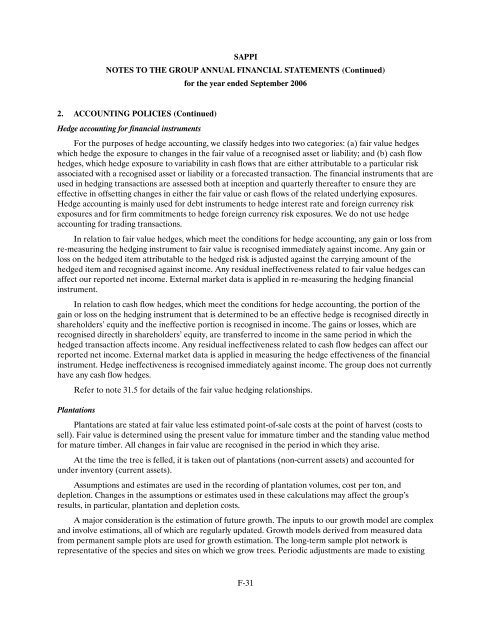Create successful ePaper yourself
Turn your PDF publications into a flip-book with our unique Google optimized e-Paper software.
SAPPI<br />
NOTES TO THE GROUP ANNUAL FINANCIAL STATEMENTS (Continued)<br />
for the year ended September <strong><strong>20</strong>06</strong><br />
2. ACCOUNTING POLICIES (Continued)<br />
Hedge accounting for financial instruments<br />
For the purposes of hedge accounting, we classify hedges into two categories: (a) fair value hedges<br />
which hedge the exposure to changes in the fair value of a recognised asset or liability; and (b) cash flow<br />
hedges, which hedge exposure to variability in cash flows that are either attributable to a particular risk<br />
associated with a recognised asset or liability or a forecasted transaction. The financial instruments that are<br />
used in hedging transactions are assessed both at inception and quarterly thereafter to ensure they are<br />
effective in offsetting changes in either the fair value or cash flows of the related underlying exposures.<br />
Hedge accounting is mainly used for debt instruments to hedge interest rate and foreign currency risk<br />
exposures and for firm commitments to hedge foreign currency risk exposures. We do not use hedge<br />
accounting for trading transactions.<br />
In relation to fair value hedges, which meet the conditions for hedge accounting, any gain or loss from<br />
re-measuring the hedging instrument to fair value is recognised immediately against income. Any gain or<br />
loss on the hedged item attributable to the hedged risk is adjusted against the carrying amount of the<br />
hedged item and recognised against income. Any residual ineffectiveness related to fair value hedges can<br />
affect our reported net income. External market data is applied in re-measuring the hedging financial<br />
instrument.<br />
In relation to cash flow hedges, which meet the conditions for hedge accounting, the portion of the<br />
gain or loss on the hedging instrument that is determined to be an effective hedge is recognised directly in<br />
shareholders’ equity and the ineffective portion is recognised in income. The gains or losses, which are<br />
recognised directly in shareholders’ equity, are transferred to income in the same period in which the<br />
hedged transaction affects income. Any residual ineffectiveness related to cash flow hedges can affect our<br />
reported net income. External market data is applied in measuring the hedge effectiveness of the financial<br />
instrument. Hedge ineffectiveness is recognised immediately against income. The group does not currently<br />
have any cash flow hedges.<br />
Refer to note 31.5 for details of the fair value hedging relationships.<br />
Plantations<br />
Plantations are stated at fair value less estimated point-of-sale costs at the point of harvest (costs to<br />
sell). Fair value is determined using the present value for immature timber and the standing value method<br />
for mature timber. All changes in fair value are recognised in the period in which they arise.<br />
At the time the tree is felled, it is taken out of plantations (non-current assets) and accounted for<br />
under inventory (current assets).<br />
Assumptions and estimates are used in the recording of plantation volumes, cost per ton, and<br />
depletion. Changes in the assumptions or estimates used in these calculations may affect the group’s<br />
results, in particular, plantation and depletion costs.<br />
A major consideration is the estimation of future growth. The inputs to our growth model are complex<br />
and involve estimations, all of which are regularly updated. Growth models derived from measured data<br />
from permanent sample plots are used for growth estimation. The long-term sample plot network is<br />
representative of the species and sites on which we grow trees. Periodic adjustments are made to existing<br />
F-31
















